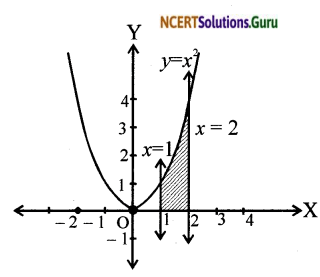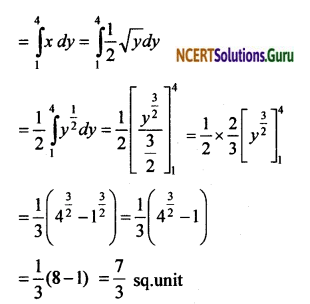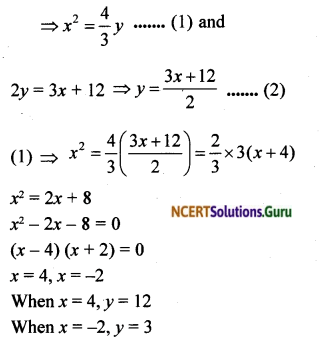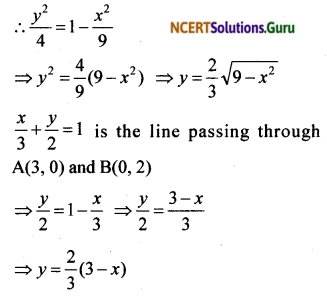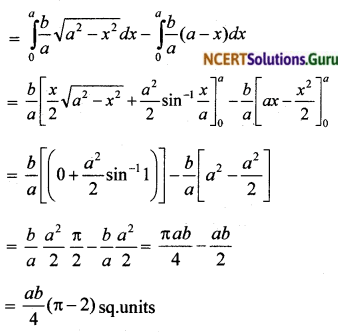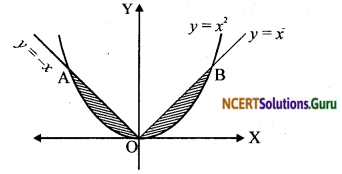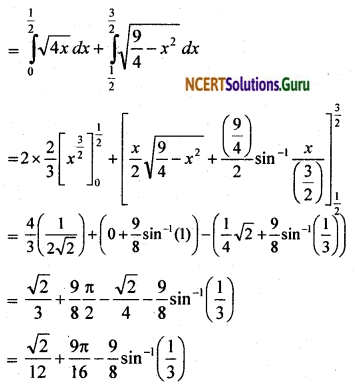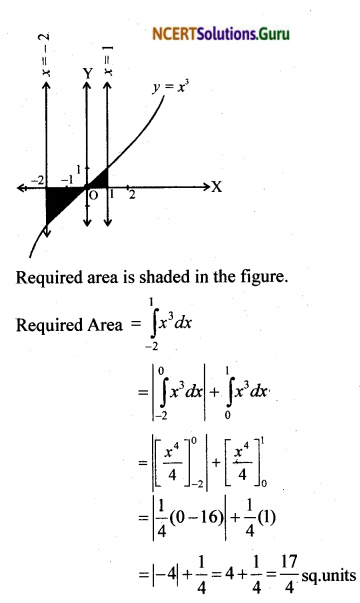These NCERT Solutions for Class 12 Maths Chapter 9 Differential Equations Ex 9.4 Questions and Answers are prepared by our highly skilled subject experts. https://mcq-questions.com/ncert-solutions-for-class-12-maths-chapter-9-ex-9-4/
NCERT Solutions for Class 12 Maths Chapter 9 Differential Equations Exercise 9.4

Class 12 Maths Chapter 9 Exercise 9.4 Question 1.
\(\frac { dy }{ dx } =\frac { 1-cosx }{ 1+cosx } \)
Solution:

y = 2tan\(\frac { x }{ 2 }\) – x + C, is the required solution.
Exercise 9.4class 12 NCERT Solutions Question 2.
\(\frac{d y}{d x}=\sqrt{4-y^{2}} \quad(-2<y<2)\)
Solution:

∴ y = 2sin (x + C), is the general solution.
Exercise 9.4 Class 12 NCERT Solutions Question 3.
\(\frac { dy }{ dx } +y=1(y\neq 1)\)
Solution:

1 – y = Ce-x ⇒ y = 1 – Ce-x
⇒ y = + Ae-x, where A = – C is the general solution.

Ex 9.4 Class 12 NCERT Solutions Question 4.
sec² x tany dx+sec² y tanx dy = 0
Solution:
sec² x tany dx+sec² y tanx dy = 0
sec² x tan x dy = – sec² x tan y dx

is the required general solution.
Ex 9.4 Class 12 Maths NCERT Solutions Question 5.
\(\left( { e }^{ x }+{ e }^{ -x } \right) dy-\left( { e }^{ x }-{ e }^{ -x } \right) dx=0\)
Solution:
\(\left( { e }^{ x }+{ e }^{ -x } \right) dy-\left( { e }^{ x }-{ e }^{ -x } \right)\)dx = 0
(ex + e-x)dy = (ex – e-x)dx
i.e., dy = \(\left(\frac{e^{x}-e^{-x}}{e^{x}+e^{-x}}\right)\)dx
Integrating both sides we get,
\(\int d y=\int \frac{e^{x}-e^{-x}}{e^{x}+e^{-x}} d x\)
i.e., y = log|ex + e-x| + C is the general solution.
Ex 9.4 Class 12 Learn Cbse NCERT Solutions Question 6.
\(\frac { dy }{ dx } =\left( { 1+x }^{ 2 } \right) \left( { 1+y }^{ 2 } \right) \)
Solution:
\(\frac { dy }{ { 1+y }^{ 2 } } =\left( { 1+x }^{ 2 } \right) dx \)
Integrating on both side we get
\({ tan }^{ -1 }y={ x+\frac { 1 }{ 3 } }x^{ 3 }+c \)
which is the required general solution.
Question 7.
y logy dx – x dy = 0
Solution:
y logy dx – x dy = 0
y logy dx = x dy
i.e., \(\frac{d x}{x}=\frac{d y}{y \log y}\)
Integrating both sides, we get

y = eCx is the general solution.
Question 8.
\({ x }^{ 5 }\frac { dy }{ dx } =-{ y }^{ 5 }\)
Solution:

Question 9.
\(\frac { dy }{ dx } ={ sin }^{ -1 }x\)
Solution:
\(\frac { dy }{ dx } ={ sin }^{ -1 }x\) ∴ dy = sin-1x dx
Integrating both sides, we get

∴ y = x sin-1x + \(\sqrt{1-x^{2}}\) + C, is the general solution.
Question 10.
\({ e }^{ x }tany\quad dx+{ (1-e }^{ x }){ sec }^{ 2 }dy=0\)
Solution:

Question 11.
\(\left(x^{3}+x^{2}+x+1\right) \frac{d y}{d x}=2 x^{2}+x\) y = 1 when x = 0
Solution:

Put x = – 1, we get 2A = 1 ∴ A = \(\frac { 1 }{ 2 }\)
Equating coefficients of x², we get
A + B = 2
∴ B = \(\frac { 3 }{ 2 }\)
Put x = 0, we get A + C = 0 ∴ C = – \(\frac { 1 }{ 2 }\)


Question 12.
\(x\left(x^{2}-1\right) \frac{d y}{d x}=1\)y = 0 when x = 2
Solution:

1 = A(x + 1)(x – 1) + Bx(x – 1) + Cx(x + 1)
When x = 0, A = – 1
When x = 1, C = \(\frac { 1 }{ 2 }\)
When x = – 1, B = \(\frac { 1 }{ 2 }\)

Question 13.
cos(\(\frac { dy }{ dx }\)) = a(a ∈ R); y = 1, when x = 0.
Solution:
cos(\(\frac { dy }{ dx }\)) = a
∴ \(\frac { dy }{ dx }\) = cos-1(a)
i.e., dy = cos-1(a)dx
Integrating both sides we get
∫dy = ∫cos-1(a)dx
i.e., y = cos-1(a) x + C …. (1)
When x = 0, y = 1
∴ 1 = 0 + C
i.e., C = 1
Substituting the value of C in (1), we get
y = x cos-1(a) + 1
y – 1 = x cos-1(a)
cos(\(\frac { y-1 }{ x }\)) = a is the required particular solution.
Question 14.
\(\frac { dy }{ dx }\) = y tan x; y = 1, when x = 0.
Solution:
\(\frac { dy }{ dx }\) ∴\(\frac { dy }{ y }\) = tanx dx
Integrating, we get ∫\(\frac { dy }{ dx }\) = ∫tan x dx
⇒ log|y| = log|secx| + log|C|
When x = 0, y = 1
⇒ log 1 = log sec0 + C ⇒ 0 = log1 + C
⇒ C = 0
∴ logy = log sec x
⇒ y = sec x is the required particular solution.

Question 15.
Find the equation of the curve passing through the point (0,0) and whose differential equation y’ = ex sin x.
Solution:
y’ = ex sin x
i.e., \(\frac { dy }{ dx }\) = ex sin x
dy = ex sinx dx
Integrating both sides, we get
∫dy = ∫ex sin x dx
i.e., y = \(\frac{e^{x}}{2}[\sin x-\cos x]+C\) … (1)
(1) passess through the point (0, 0)
we get 0 = \(\frac { 1 }{ 2 }\) [0 – 1] + C
∴ C = \(\frac { 1 }{ 2 }\)
∴ (1) → y = \(\frac{e^{x}}{2}[\sin x-\cos x]\) + \(\frac { 1 }{ 2 }\)
i.e., 2y = ex[sinx – cosx] + 1
2y – 1 = ex [sinx – cosx], is the equation of the curve.
Question 16.
For the differential equation xy \(\frac { dy }{ dx }\) = (x + 2) (y + 2), find the solution curve passing through the point (1, – 1)
Solution:

y – 2 log |y + 2| = x + 2 log |x| + C
y – x = log (y + 2)² + logx² + C
y – x = log (x(y + 2))² + C … (1)
(1) passess through (1, – 1), we get
– 1 – 1 = log 1 + C
– 2 = C ⇒ C = – 2
(1) → y – x = log x(x(y + 2))² – 2
i.e., y – x + 2 = log(x(y + 2))², is the equation of the curve.
Question 17.
Find the equation of a curve passing through the point (0, -2) given that at any point (pc, y) on the curve the product of the slope of its tangent and y-coordinate of the point is equal to the x-coordinate of the point
Solution:
According to the question \(y\frac { dy }{ dx } =x\)
\(\Rightarrow \int { ydy } =\int { xdx } \Rightarrow \frac { { y }^{ 2 } }{ 2 } =\frac { { x }^{ 2 } }{ 2 } +c\)
0, – 2) lies on it.c = 2
∴ Equation of the curve is : x² – y² + 4 = 0.

Question 18.
At any point (x, y) of a curve the slope of the tangent is twice the slope of the line segment joining the point of contact to the point (-4,-3) find the equation of the curve given that it passes through (- 2,1).
Solution:
The slope of the line points (x, y) and (- 4, 3) is \(\frac { y+3 }{ x+4 }\)
Also the slope of the tangent at any point on the curve is \(\frac { dy }{ dx }\)

Since it passes through the point (-2, 1), we get log(1 + 3) = log (-2 + 4)² + C
log 4 = log 4 + C
⇒ C = 0
∴ log|y + 3| = log(x + 4)²
⇒ y + 3 = (x + 4)² is the equation of the curve.
Question 19.
The volume of a spherical balloon being inflated changes at a constant rate. If initially its radius is 3 units and offer 3 seconds it is 6 units. Find the radius of balloon after t seconds.
Solution:


Question 20.
In a bank principal increases at the rate of r% per year. Find the value of r if Rs 100 double itself in 10 years
Solution:
Let Pt be the principal after t years.
The initial principal P0 = ₹ 100
Rate of interest = r %, time t = 10 years
P10 = 200
Given that \(\frac{d P}{d t}=\frac{r}{100} \mathrm{P} \Rightarrow \frac{d P}{P}=\frac{r}{100} d t\)
Integrating both sides, we get

Question 21.
In a bank principal increases at the rate of 5% per year. An amount of Rs 1000 is deposited with this bank, how much will it worth after 10 years
Solution:
Let Pt be the principal after t years.
The initial principal P0 = 1000
Rate of interest = 5 %, time t = 10 years
Given that \(\frac{d P}{d t}=\frac{5}{100} \mathrm{P} \Rightarrow \frac{d P}{P}=\frac{1}{20} d t\)
Integrating both sides, we get

Question 22.
In a culture the bacteria count is 1,00,000. The number is increased by 10% in 2 hours. In how many hours will the count reach 2,00,000 if the rate of growth of bacteria is proportional to the number present
Solution:
Let N1 be the count of bacteria at any time t. Initial count of bacteria be N0.
Given that \(\frac { dN }{ dt }\) ∝ N
⇒ \(\frac { dN }{ dt }\) = kN
\(\frac { dN }{ N }\) = k dt
Integrating both sides, we get ∫\(\frac { dN }{ N }\) = ∫k dt
⇒ log N = kt + C … (1)
When t = 0, N = N0 = 100000
i.e., C = log 100000
(1) ⇒ logN = kt + log 100000
log N – log 100000 = kt
log(\(\frac { N }{ 100000 }\)) = kt … (2)
When t = 2, N = N2


Question 23.
The general solution of a differential equation \(\frac{d y}{d x}=e^{x+y} \text { is }\)
(a) \({ e }^{ x }+{ e }^{ -y }=c \)
(b) \({ e }^{ x }+{ e }^{ y }=c \)
(c) \({ e }^{ -x }+{ e }^{ y }=c \)
(d) \({ e }^{ -x }+{ e }^{ -y }=c \)
Solution:
(a) \(\frac { dy }{ dx } ={ e }^{ x }.{ e }^{ y }\Rightarrow \int { { e }^{ -y }dy } =\int { { e }^{ x }dx } \)
\(\Rightarrow { e }^{ -y }={ e }^{ x }+k\Rightarrow { e }^{ x }+{ e }^{ -y }=C \) is the general solution.
![]()
![]()
![]()
![]()
![]()












